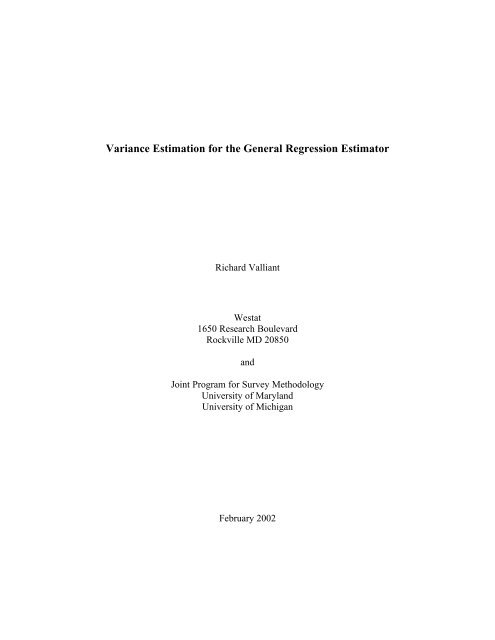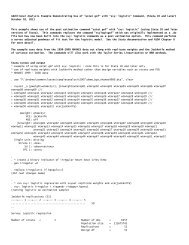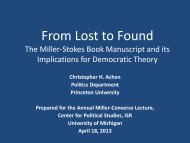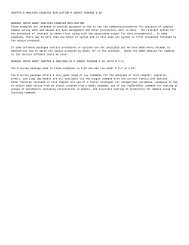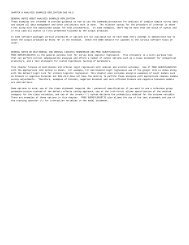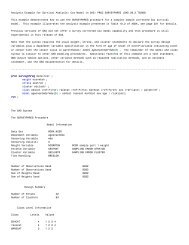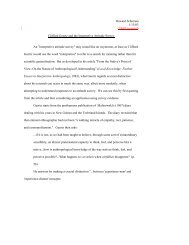Variance Estimation for the General Regression Estimator
Variance Estimation for the General Regression Estimator
Variance Estimation for the General Regression Estimator
You also want an ePaper? Increase the reach of your titles
YUMPU automatically turns print PDFs into web optimized ePapers that Google loves.
<strong>Variance</strong> <strong>Estimation</strong> <strong>for</strong> <strong>the</strong> <strong>General</strong> <strong>Regression</strong> <strong>Estimator</strong><br />
Richard Valliant<br />
Westat<br />
1650 Research Boulevard<br />
Rockville MD 20850<br />
and<br />
Joint Program <strong>for</strong> Survey Methodology<br />
University of Maryland<br />
University of Michigan<br />
February 2002
1<br />
ABSTRACT<br />
A variety of estimators of <strong>the</strong> variance of <strong>the</strong> general regression (GREG) estimator of a<br />
mean have been proposed in <strong>the</strong> sampling literature, mainly with <strong>the</strong> goal of estimating <strong>the</strong><br />
design-based variance. <strong>Estimator</strong>s can be easily constructed that, under certain conditions, are<br />
approximately unbiased <strong>for</strong> both <strong>the</strong> design-variance and <strong>the</strong> model-variance. Several dualpurpose<br />
estimators are studied here in single-stage sampling. These choices are robust<br />
estimators of a model-variance even if <strong>the</strong> model that motivates <strong>the</strong> GREG has an incorrect<br />
variance parameter.<br />
A key feature of <strong>the</strong> robust estimators is <strong>the</strong> adjustment of squared residuals by factors<br />
analogous to <strong>the</strong> leverages used in standard regression analysis. We also show that <strong>the</strong> deleteone<br />
jackknife implicitly includes <strong>the</strong> leverage adjustments and is a good choice from ei<strong>the</strong>r <strong>the</strong><br />
design-based or model-based perspective. In a set of simulations, <strong>the</strong>se variance estimators have<br />
small bias and produce confidence intervals with near-nominal coverage rates <strong>for</strong> several<br />
sampling methods, sample sizes, and populations in single-stage sampling.<br />
We also present simulation results <strong>for</strong> a skewed population where all variance estimators<br />
per<strong>for</strong>m poorly. Samples that do not adequately represent <strong>the</strong> units with large values lead to<br />
estimated means that are too small, variance estimates that are too small, and confidence<br />
intervals that cover at far less than <strong>the</strong> nominal rate. These defects need to be avoided at <strong>the</strong><br />
design stage by selecting samples that cover <strong>the</strong> extreme units well. However, in populations<br />
with inadequate design in<strong>for</strong>mation this will not be feasible.<br />
KEY WORDS: Confidence interval coverage; Hat matrix; Jackknife; Leverage;<br />
Model unbiased; Skewness
1<br />
1. Introduction<br />
Robust variance estimation is a key consideration in <strong>the</strong> prediction approach to finite<br />
population sampling. Valliant, Dorfman, and Royall (2000) syn<strong>the</strong>size much of <strong>the</strong> model-based<br />
literature. In that approach, a working model is <strong>for</strong>mulated that is used to construct a point<br />
estimator of a mean or total. <strong>Variance</strong> estimators are created that are robust in <strong>the</strong> sense of being<br />
approximately model-unbiased and consistent <strong>for</strong> <strong>the</strong> model-variance even when <strong>the</strong> variance<br />
specification in <strong>the</strong> working model is incorrect. In this paper, that approach is extended to <strong>the</strong><br />
general regression estimator (GREG) to construct variance estimators that are approximately<br />
model-unbiased but are also approximately design-unbiased in single-stage sampling. A number<br />
of alternatives are compared including <strong>the</strong> jackknife and some variants of <strong>the</strong> jackknife. We will<br />
use a particular class of linear models along with Bernoulli or Poisson sampling as motivation<br />
<strong>for</strong> <strong>the</strong> variance estimators. However, some of <strong>the</strong>se estimators can often be successfully applied<br />
in practice to single-stage designs where selections are not independent.<br />
Associated with each unit in <strong>the</strong> population is a target variable Y i and a p-vector of<br />
auxiliary variables i = ( i1, , ip)<br />
x x K x ′ where i = 1, K , N . The population vector of totals of <strong>the</strong><br />
auxiliaries is x = ( x1, , xp)<br />
T T K T ′ where<br />
T<br />
xk<br />
=∑ x , k = 1, K , p. The general regression<br />
N<br />
i=<br />
1<br />
ki<br />
estimator, defined below, is motivated by a linear model in which <strong>the</strong> Y’s are independent<br />
random variables with<br />
E<br />
var<br />
( Y )<br />
( Y )<br />
M i i<br />
= xβ ′<br />
. (1.1)<br />
= v<br />
M i i<br />
In most situations (1.1) is a “working” model that is likely to be incorrect to some degree.
2<br />
Assume that a probability sample s is selected and that <strong>the</strong> selection probability of sample<br />
unit i is P( δ 1)<br />
i = = πi<br />
where i<br />
δ is a 0-1 indicator <strong>for</strong> whe<strong>the</strong>r a unit is in <strong>the</strong> sample or not. We<br />
assume that <strong>the</strong> sample selection mechanism is ignorable. Roughly speaking, ignorability means<br />
that <strong>the</strong> joint distribution of <strong>the</strong> Y’s and <strong>the</strong> sample indicators, given <strong>the</strong> x’s, can be factored into<br />
<strong>the</strong> product of <strong>the</strong> distribution <strong>for</strong> Y given x and <strong>the</strong> distribution <strong>for</strong> <strong>the</strong> indicators given x (see<br />
Sugden and Smith 1984 <strong>for</strong> a <strong>for</strong>mal definition). In that case, model-based inference can<br />
proceed using <strong>the</strong> model and ignoring <strong>the</strong> selection mechanism.<br />
The n-vector of targets <strong>for</strong> <strong>the</strong> sample units is = ( )<br />
auxiliaries <strong>for</strong> <strong>the</strong> sample units is X = ( x K x )<br />
probabilities as = diag( π )<br />
s<br />
i<br />
1, ,<br />
s n ′<br />
Ys<br />
Y1, K , Y ′<br />
n , and <strong>the</strong> n× p matrix of<br />
. Define <strong>the</strong> diagonal matrix of selection<br />
Π , i∈ s, and <strong>the</strong> diagonal matrix of model-variances as<br />
V<br />
s<br />
= diag( v ) . The GREG estimator of <strong>the</strong> total,<br />
i<br />
T<br />
=∑ , is <strong>the</strong>n defined as <strong>the</strong> Horvitz-<br />
N<br />
Y<br />
i=<br />
1 i<br />
Thompson estimator or π -estimator, T ˆ<br />
π<br />
=∑ Y π , plus an adjustment:<br />
s<br />
i<br />
i<br />
( )<br />
Tˆ = Tˆ ˆ ˆ<br />
π + B′<br />
T −T (1.2)<br />
G x x<br />
where<br />
Bˆ<br />
= A XV Π Y with<br />
1 1 1<br />
π − s ′ s s − s −<br />
s<br />
−1 −1<br />
πs = ′ s s s s<br />
=∑<br />
A XV Π X , and T ˆx x i πi<br />
. The GREG<br />
s<br />
estimator can also be written as<br />
−1 −1 with (<br />
ˆ<br />
π )<br />
s s s s x x s<br />
1<br />
TˆG =g′<br />
−<br />
s s Y s<br />
Π (1.3)<br />
g = V XA T − T + 1 and 1 s being an n-vector of 1’s. Expression (1.3) will be<br />
useful <strong>for</strong> subsequent calculations.<br />
A variant of <strong>the</strong> GREG, referred to as a “cosmetic” estimator, was introduced by Särndal<br />
and Wright (1984) and amplified by Brewer (1995, 1999). A cosmetic estimator also has design-
3<br />
based and model-based interpretations. The variance estimators in this paper could also be<br />
adapted to cover cosmetic estimation.<br />
Assuming that N is known, <strong>the</strong> GREG estimator of <strong>the</strong> mean is simply Y ˆ = Tˆ<br />
N . We<br />
will concentrate on <strong>the</strong> analysis of Y ˆG. (In some situations, particularly ones where multi-stage<br />
G<br />
G<br />
sampling is used, <strong>the</strong> population size is unknown and an estimate, ˆN , must be used in <strong>the</strong><br />
denominator of Y ˆG. The following analysis <strong>for</strong> <strong>the</strong> mean does not apply in that case.) Ei<strong>the</strong>r<br />
quantitative or qualitative auxiliaries (or both) can be used in <strong>the</strong> GREG. If a qualitative variable<br />
like gender (male or female) is used, <strong>the</strong>n two or more columns in<br />
in which case a generalized inverse, denoted by<br />
X s will be linearly dependent,<br />
A π −<br />
s, will be used in (1.2) and (1.3). Note that,<br />
although<br />
A π −<br />
s is not unique, <strong>the</strong> GREG estimator Y ˆG is invariant to <strong>the</strong> choice of generalized<br />
inverse. The proof is similar to Theorem 7.4.1 in Valliant, Dorfman, and Royall (2000).<br />
The GREG estimator is model-unbiased under (1.1) and is approximately designunbiased<br />
in large probability samples. Note that <strong>the</strong> model-unbiasedness requires only that<br />
( )<br />
E Y = xβ; ′ if <strong>the</strong> variance parameters in (1.1) are misspecified, <strong>the</strong> GREG will still be<br />
M i i<br />
model-unbiased. On <strong>the</strong> o<strong>the</strong>r hand, if ( )<br />
M<br />
i<br />
E Y is incorrectly specified, <strong>the</strong> GREG is modelbiased<br />
and <strong>the</strong> model mean squared error may contain an important bias-squared term. The<br />
estimation error of <strong>the</strong> GREG Y ˆG is defined as<br />
ˆG − = s s − r r<br />
1 ( aY 1Y )<br />
Y Y N − ′ ′<br />
where Y<br />
= T N ,<br />
−1<br />
s = s s − s<br />
a Π g 1 , r<br />
Y is <strong>the</strong> ( N −n)<br />
-vector of target variables <strong>for</strong> <strong>the</strong><br />
nonsample units, and 1 r is a vector of N − n 1’s. Next, suppose that <strong>the</strong> true model <strong>for</strong> Y i is
E<br />
var<br />
( Y )<br />
( Y )<br />
M i i<br />
= x′<br />
β<br />
, (1.4)<br />
= ψ<br />
M i i<br />
i.e., <strong>the</strong> variance specification is different from (1.1) but ( )<br />
E Y is <strong>the</strong> same. Using <strong>the</strong><br />
M<br />
i<br />
4<br />
estimation error, <strong>the</strong> error-variance of Y ˆG is <strong>the</strong>n<br />
where <strong>the</strong> n× n covariance matrix <strong>for</strong> s<br />
2<br />
( Y<br />
ˆ<br />
− Y) = N − ( a′ Ψ<br />
a + 1′<br />
Ψ<br />
1 )<br />
var M G s s s r r r<br />
Y is =diag( ψ )<br />
Ø s<br />
i and r<br />
Ø is <strong>the</strong> ( N − n) × ( N−n)<br />
covariance matrix <strong>for</strong><br />
Y r . When <strong>the</strong> sample and population sizes are both large and <strong>the</strong><br />
sampling fraction, f<br />
= nN , is negligible, <strong>the</strong> error-variance is approximately<br />
ˆ<br />
−2 2<br />
( )<br />
var M Y G Y N a i ψ i<br />
i∈s<br />
Note that this variance depends on <strong>the</strong> true variance parameters,<br />
− ≅ ∑ . (1.5)<br />
ψ i, and on <strong>the</strong> working model<br />
variance parameters, v i, because v i is part of a i. Since a s is approximately <strong>the</strong> same as<br />
when selection probabilities are small, <strong>the</strong> error variance in that case is also approximately<br />
var<br />
ˆ<br />
( )<br />
2<br />
−2<br />
gi<br />
M YG Y N ψ<br />
2 i<br />
i∈sπi<br />
1<br />
s s<br />
Π − g<br />
− ≅ ∑ (1.6)<br />
For model-based variance estimation, we will take ei<strong>the</strong>r of <strong>the</strong> asymptotic <strong>for</strong>ms in (1.5) or (1.6)<br />
as <strong>the</strong> target. However, when <strong>the</strong> sampling fraction is substantial, <strong>the</strong> term<br />
′<br />
2<br />
r r r N<br />
1 Ψ 1 can be<br />
an important part of <strong>the</strong> error-variance and (1.5) or (1.6) may be poor approximations.<br />
We will consider <strong>the</strong> design variance under two single-stage plans—Bernoulli and<br />
Poisson. In Poisson sampling, <strong>the</strong> indicators δ i <strong>for</strong> whe<strong>the</strong>r a unit is in <strong>the</strong> sample or not are<br />
independent with P( 1) 1 P( 0)<br />
δ = = − δ = = π (see Särndal, Swensson, and Wretman 1992, sec.<br />
i i i
5<br />
3.5, <strong>for</strong> a more detailed description). Bernoulli sampling is a special case of Poisson sampling in<br />
which each unit has <strong>the</strong> same inclusion probability. Under <strong>the</strong>se two plans, <strong>the</strong> approximate<br />
design-variance of Y ˆG is<br />
where E i Y i i ′<br />
var<br />
−<br />
−<br />
= −xB and = ( ) 1<br />
π<br />
( Y ˆ 2 N 2<br />
) 1 i<br />
G N − −π<br />
i=<br />
1<br />
E i<br />
≅ ∑ (1.7)<br />
π<br />
1 −1<br />
i<br />
B XV ′ X XV ′ Y is <strong>the</strong> regression parameter estimator<br />
evaluated <strong>for</strong> <strong>the</strong> full finite population. Särndal (1996) recommends using <strong>the</strong> GREG in<br />
conjunction with sampling plans <strong>for</strong> which (1.7) is valid on <strong>the</strong> grounds that <strong>the</strong> variance (1.7) is<br />
simple and that <strong>the</strong> use of regression estimation can often more than compensate <strong>for</strong> <strong>the</strong> random<br />
sample sizes that are a consequence of such designs.<br />
The Bernoulli and Poisson designs and <strong>the</strong> linear models (1.1) and (1.4) serve mainly as<br />
motivation <strong>for</strong> <strong>the</strong> variance estimators presented in sections 2 and 3. As noted by Yung and Rao<br />
(1996, p.24), it is common practice to use variance estimators that are appropriate to a design<br />
with independent selections or to a with-replacement design even when a sample has been<br />
selected without replacement. Likewise, variance estimators motivated by a linear model are<br />
often applied in cases where departures from <strong>the</strong> model are anticipated. This practical approach<br />
underlies <strong>the</strong> thinking in this paper and is illustrated in <strong>the</strong> simulation study reported in section 4.<br />
2. <strong>Variance</strong> <strong>Estimator</strong>s<br />
Our general goal in variance estimation will be to find estimators that are consistent and<br />
approximately unbiased under both a model and a design. Kott (1990) also considered this<br />
problem. Note that <strong>the</strong> goal here is not <strong>the</strong> estimation of a combined (or anticipated) model-
6<br />
⎧<br />
⎨<br />
⎪<br />
⎢<br />
⎩⎣<br />
⎪<br />
design variance,<br />
ˆ<br />
ˆ<br />
( ) ( ) 2<br />
E E ⎡ Y Y E E Y Y ⎤<br />
− − −<br />
M π G M π G<br />
useful <strong>for</strong> both var<br />
ˆ<br />
M ( Y G − Y)<br />
and var<br />
ˆ<br />
π ( Y G)<br />
⎥⎦<br />
⎫⎪<br />
⎬. Ra<strong>the</strong>r we seek estimators that are<br />
⎪⎭<br />
. The arguments given here are largely heuristic<br />
ones used to motivate <strong>the</strong> <strong>for</strong>ms of <strong>the</strong> variance estimators. Additional, <strong>for</strong>mal conditions such<br />
as those found in Royall and Cumberland (1978) or Yung and Rao (2000) are needed <strong>for</strong> modelbased<br />
and design-based consistency and approximate unbiasedness.<br />
First, consider estimation of <strong>the</strong> approximate model-variance given in (1.5). In <strong>the</strong><br />
following development, we assume that, as N and n become large,<br />
(i) Nmax( ) O( n)<br />
i<br />
π = and<br />
i<br />
(ii) A πs N converges to a matrix of constants, A o.<br />
A residual associated with sample unit i is<br />
r = Y − Yˆ<br />
where Y ˆ =xB. ′ ˆ The vector of<br />
i i i<br />
i<br />
i<br />
predicted values <strong>for</strong> <strong>the</strong> sample units can be written as<br />
Yˆs = HY s s<br />
(2.1)<br />
where<br />
1 1 1<br />
s = s π − s ′ s s − s<br />
−<br />
=∑ ∈<br />
H XA XV Π . The predicted value <strong>for</strong> an individual unit is Y ˆi hY ij j<br />
j s<br />
1<br />
where hij ′<br />
−<br />
i πs j ( vjπ<br />
j)<br />
=xA x is <strong>the</strong> (ij) th element of H s. The matrix<br />
H s is <strong>the</strong> analog to <strong>the</strong><br />
usual hat matrix (Belsley, Kuh, and Welsch 1980) from standard regression analysis. The<br />
diagonal elements of <strong>the</strong> hat matrix are known as leverages and are a measure of <strong>the</strong> effect that a<br />
unit has on its own predicted value. Notice that <strong>the</strong> inverses of <strong>the</strong> selection probabilities are<br />
involved in (2.1), although <strong>the</strong>se would have no role in purely model-based analysis.<br />
The following lemma, which is a variation of some results in Lemma 5.3.1 of (Valliant,<br />
Dorfman, and Royall 2000), gives some properties of <strong>the</strong> leverages and <strong>the</strong> hat matrix.
7<br />
Lemma 1. Assume that (i) and (ii) hold. For<br />
1 1 1<br />
s = s π − s ′ s s − s<br />
−<br />
H XA XV Π <strong>the</strong> following properties<br />
hold <strong>for</strong> all i∈ s:<br />
1<br />
(a) hij<br />
= O( n −<br />
)<br />
(b)<br />
H s is idempotent.<br />
(c) 0≤h ii ≤ 1.<br />
1<br />
Proof: Since hij ′<br />
−<br />
i πs j ( vjπ<br />
j)<br />
1<br />
=xA x , conditions (i) and (ii) imply that hij<br />
O( n −<br />
)<br />
= . Part (b)<br />
follows from direct multiplication, using <strong>the</strong> definition of<br />
H . To prove (c) note that h ≥0<br />
s<br />
ii<br />
since it is a quadratic <strong>for</strong>m. Part (b) implies that<br />
2<br />
ii ii j≠i<br />
ij ji<br />
h = h +∑ hh which can hold only if<br />
h ≤ 1.<br />
ii<br />
Next, we write <strong>the</strong> residual as r = Y ( 1−h ) − ∑ hY where ( )<br />
excluding unit i. Since ( ) 0<br />
M<br />
i<br />
i i ii ij j<br />
j∈si<br />
( )<br />
2<br />
E r = , we have E ( r ) var ( r )<br />
( ) ψ ( 1 )<br />
= and<br />
M i M i<br />
2 2 2<br />
s i is <strong>the</strong> sample<br />
EM ri = i − hii + ∑ hijψ<br />
j<br />
(2.2)<br />
j∈si<br />
( )<br />
2<br />
under model (1.4). Using Lemma 1(a), we have h = o( 1)<br />
, h o( 1)<br />
2<br />
( )<br />
E r ≅ ψ . Thus, in large samples,<br />
M i i<br />
ii<br />
ij<br />
= , and consequently,<br />
2<br />
r i is an approximately unbiased estimator of <strong>the</strong> correct<br />
model-variance even though <strong>the</strong> variance specification in model (1.1) was incorrect. As a result,
8<br />
2<br />
r i is a robust estimator of <strong>the</strong> model-variance <strong>for</strong> unit i regardless of <strong>the</strong> <strong>for</strong>m of ψ i. A simple,<br />
robust estimator of <strong>the</strong> approximate model-variance (1.5) is <strong>the</strong>n<br />
−2 2 2<br />
( ) s<br />
v Y = N ∑ ar<br />
(2.3)<br />
ˆ<br />
R1 G i i<br />
which is a type of “sandwich” estimator (see, e.g., White 1982). (Note that a <strong>for</strong>mal argument<br />
that R1<br />
−<br />
v is robust would require conditions such that n 1 E ( v )<br />
M R1<br />
−<br />
and n 1 N − 2 ∑ ai 2 ψ<br />
s i<br />
converge to <strong>the</strong> same quantity.) Ano<strong>the</strong>r variance estimator, similar to v R1<br />
if<br />
ˆ<br />
( )<br />
2<br />
−2 gi<br />
2<br />
R2 G s 2 i<br />
πi<br />
a<br />
−1<br />
s ≅Π<br />
s gs<br />
v Y = N ∑ r . (2.4)<br />
An estimator of <strong>the</strong> approximate design-variance in (1.7) is<br />
ˆ −2 1−πi<br />
2<br />
( G) s 2 i<br />
v π Y = N ∑<br />
π<br />
r . (2.5)<br />
An alternative suggested by Särndal, Swensson, and Wretman (1989) as having better<br />
conditional properties is<br />
ˆ −2 1−πi<br />
2 2<br />
( ) s 2<br />
SSW G i i<br />
πi<br />
i<br />
v Y = N ∑ g r . (2.6)<br />
Ano<strong>the</strong>r, similar estimator, used in <strong>the</strong> SUPERCARP software (Hidiroglou, Fuller, and Hickman<br />
1980) and derived using Taylor series methods, is<br />
ˆ<br />
( )<br />
2<br />
−2 n ⎛ gr ii 1 gr ii<br />
⎞<br />
T G = ∑<br />
1 s⎜<br />
− π<br />
∑ s ⎟ . (2.7)<br />
i π i<br />
v Y N n − ⎝ n ⎠<br />
As shown in <strong>the</strong> Appendix, <strong>the</strong> second term in paren<strong>the</strong>ses in (2.7) converges in probability to<br />
zero under model (1.1). Thus, vT<br />
≈ vR2<br />
in large samples.<br />
, is
9<br />
When <strong>the</strong> selection probability of each unit is small, v SSW will be similar to v R1, v R2,<br />
and v T . All three will be approximately model-unbiased under (1.4) and approximately designunbiased<br />
under Bernoulli and Poisson sampling. On <strong>the</strong> o<strong>the</strong>r hand, v π is approximately designunbiased<br />
but ignores <strong>the</strong> g i coefficients and is biased under ei<strong>the</strong>r model (1.1) or (1.4).<br />
As a simple example, consider Bernoulli sampling with π i = nN and <strong>the</strong> working model<br />
2<br />
( ) = , ( Y ) σ<br />
E Y x β<br />
M i i<br />
var M i x i<br />
= . Then <strong>the</strong> GREG is <strong>the</strong> ratio estimator Y ˆG = Ys x xs<br />
where x<br />
is a finite population mean. The approximate model variance under <strong>the</strong> more general<br />
specification, ( Y ) = ψ , is ( n) ( x x ) 2<br />
var M i i<br />
N<br />
design-variance is ( 1−<br />
f ) ( nN) ( Y −xY x) 2<br />
−2<br />
estimator ( ) 2<br />
( ) 2<br />
R2<br />
s s i i s s<br />
ψ s s where s s i<br />
ψ<br />
=∑ ψ n. The approximate<br />
∑ i=<br />
1 i i where Y is a finite population mean. The<br />
p<br />
v = n x x ∑ Y −xY x is approximately unbiased <strong>for</strong> <strong>the</strong> modelvariance<br />
and, because x xs<br />
⎯⎯→ 1 in large Bernoulli samples, v R2<br />
is also approximately<br />
unbiased <strong>for</strong> <strong>the</strong> design-variance as long as f is small. In contrast,<br />
vπ<br />
= n − f ∑ Y −xY x is approximately design-unbiased but is model-unbiased<br />
( ) ( ) 2<br />
−2 1<br />
s i i s s<br />
only in balanced samples where<br />
x = x . Royall and Cumberland (1981) noted similar results <strong>for</strong><br />
s<br />
<strong>the</strong> ratio estimator in simple random sampling without replacement.<br />
3. Alternative <strong>Variance</strong> <strong>Estimator</strong>s Using Adjusted Squared Residuals<br />
The first alternative variance estimator we consider is <strong>the</strong> jackknife. The particular<br />
version to be studied is defined as
10<br />
n<br />
2<br />
n−1 v<br />
ˆ ˆ<br />
J = ⎡YGi ( ) Y ⎤<br />
∑ G<br />
n ⎢<br />
−<br />
⎣ ( ⋅)<br />
⎥<br />
(3.1)<br />
⎦<br />
i=<br />
1<br />
where Y<br />
ˆGi ( ) has <strong>the</strong> same <strong>for</strong>m as <strong>the</strong> full sample estimator after omitting sample unit i. If <strong>the</strong><br />
selection probability has <strong>the</strong> <strong>for</strong>m π i = np i<br />
, <strong>the</strong>n (3.1) can be rewritten. Using <strong>the</strong> convention<br />
that <strong>the</strong> subscript (i) means that sample unit i has been omitted, we have<br />
Y ˆ ˆ<br />
Gi ( ) = T Gi ( ) N , Y ˆ<br />
( ) ˆ<br />
G ⋅ Y Gi ( ) n<br />
=∑ , T ˆ Gi ( ) = T ˆ ( i) ˆ ( i) x<br />
ˆ<br />
π + ′ − xi ( )<br />
i∈s<br />
( i) = ∑ j<br />
⎡π<br />
j( − ) ⎤, Tˆ ( i) = n ∑ j<br />
⎡π<br />
j( n − 1 )<br />
Tˆ π n Y ⎣<br />
n 1 ⎦<br />
j∈si<br />
( )<br />
ˆ −1 −1 −1<br />
i πsi si si si si<br />
( )<br />
B T T ,<br />
⎤<br />
x x<br />
⎣ ⎦<br />
, and<br />
j∈si<br />
( )<br />
−1 −1<br />
si si<br />
B( ) = A X′<br />
( ) ( ) V<br />
( ) Π Y<br />
( ) ( ) with Aπsi ( ) = X′<br />
si ( ) V ( ) Π ( ) Xsi<br />
( ) .<br />
Ano<strong>the</strong>r more conservative, but asymptotically equivalent, version of <strong>the</strong> jackknife replaces<br />
Y<br />
ˆG( ⋅ ) with <strong>the</strong> full sample estimator Y ˆG. Design-based properties of <strong>the</strong> jackknife in (3.1) are<br />
usually studied in samples selected with replacement (see, e.g., Krewski and Rao 1981, Rao and<br />
Wu 1985, Yung and Rao 1996), but applied in practice to without-replacement designs. Note<br />
that <strong>for</strong> <strong>the</strong> linear estimator<br />
π<br />
i∈s<br />
i<br />
i<br />
ˆ −1<br />
Y = N ∑ Y π in probability proportional to size withoutreplacement<br />
sampling, nei<strong>the</strong>r <strong>the</strong> jackknife, v J , nor <strong>the</strong> approximations to v J given later in this<br />
section, reduce to <strong>the</strong> usual Horvitz-Thompson or Yates-Grundy variance estimators.<br />
With some ef<strong>for</strong>t we can write <strong>the</strong> jackknife in a <strong>for</strong>m that involves <strong>the</strong> residuals and <strong>the</strong><br />
leverages. The rewritten <strong>for</strong>m will make clear <strong>the</strong> relationship of <strong>the</strong> jackknife to <strong>the</strong> variance<br />
estimators in section 2. First, note <strong>the</strong> following equalities that are easily verified:<br />
ˆ n ⎛<br />
ˆ Yi<br />
⎞<br />
Tπ( i) = ⎜Tπ<br />
1 ( i<br />
n ) − ⎟, ˆ n ⎛<br />
ˆ xi<br />
⎞<br />
Txi<br />
− ⎝ π ( ) = ⎜T xi ( ) − ⎟<br />
(3.2)<br />
i ⎠ n−1<br />
⎝ πi<br />
⎠
11<br />
−1 −1 −1 −1<br />
si si<br />
X′ si ( ) V Π Y<br />
( ) ( ) si ( ) = XV ′ s s Π s Ys −xiYi vπ i i , Aπsi<br />
( ) = Aπs −xx i i′<br />
viπi<br />
(3.3)<br />
Using a standard <strong>for</strong>mula <strong>for</strong> <strong>the</strong> inverse of <strong>the</strong> sum of two matrices, <strong>the</strong> slope estimator,<br />
omitting sample unit i, equals<br />
−1<br />
ˆ ˆ −1<br />
s i r<br />
B<br />
π i<br />
( i)<br />
= B + n ∑ A x .<br />
s<br />
1−h<br />
vπ<br />
ii i i<br />
Details of this and <strong>the</strong> succeeding computations are sketched in <strong>the</strong> Appendix. After a<br />
considerable amount of algebra, we have<br />
ˆ ˆ n<br />
n<br />
TGi<br />
( ) − TG( ⋅) =− ( Di − Ds)<br />
+ Fi<br />
n−1 n−1<br />
where<br />
D<br />
i<br />
=<br />
π<br />
i<br />
gr<br />
ii<br />
( 1−h<br />
)<br />
ii<br />
and F i is defined in <strong>the</strong> Appendix. The jackknife in (3.1) is <strong>the</strong>n equal to<br />
ˆ<br />
( ) 2 n<br />
2<br />
= ( − ) + 2 −2<br />
s s s<br />
( − )<br />
−<br />
vJ YG N ⎡ Di Ds Fi Fi Di D ⎤<br />
s<br />
n 1⎢⎣<br />
⎥⎦<br />
−<br />
∑ ∑ ∑ . (3.4)<br />
Expression (3.4) is an exact equality and could be used as a computational <strong>for</strong>mula <strong>for</strong> <strong>the</strong><br />
jackknife. This would sidestep <strong>the</strong> need to mechanically delete a unit, compute Y<br />
ˆGi ( ) , and so on,<br />
through <strong>the</strong> entire sample.<br />
In large samples <strong>the</strong> first term in brackets in (3.4) is dominant while <strong>the</strong> second and third<br />
are near zero under some reasonable conditions. Thus, in large samples <strong>the</strong> jackknife is<br />
ˆ<br />
∑<br />
−2<br />
approximated by v ( Y ) ≅ N ( D −D<br />
) 2<br />
J G s i s<br />
v<br />
, or, equivalently,<br />
2 2<br />
ˆ 1 gr ii 1 gr<br />
( Y ) ≅<br />
−<br />
ii<br />
2 π ( 1−h<br />
)<br />
2 π ( 1−h<br />
)<br />
⎡ ⎤ ⎡ ⎤<br />
⎢ ⎥ ⎢ ⎥<br />
⎢⎣ ⎥⎦ ⎢⎣ ⎥⎦<br />
∑ ∑ . (3.5)<br />
J G s s<br />
N i ii N n i ii
12<br />
As shown in <strong>the</strong> Appendix, <strong>the</strong> second term in (3.5) converges in probability to zero under model<br />
(1.1). Consequently, a fur<strong>the</strong>r approximation to <strong>the</strong> jackknife is<br />
v<br />
2 2<br />
ˆ 1 gi r<br />
( Y ) ≅<br />
i<br />
N<br />
2<br />
π ( 1−h<br />
)<br />
∑ . (3.6)<br />
J G 2 s<br />
2<br />
i ii<br />
As (3.5) and (3.6) show, <strong>the</strong> jackknife implicitly incorporates <strong>the</strong><br />
g i<br />
2 coefficients needed <strong>for</strong><br />
estimating <strong>the</strong> model-variance. The right-hand side of (3.6) is itself an alternative estimator that<br />
∗<br />
we will denote by v<br />
ˆ<br />
J ( YG<br />
)<br />
.<br />
Yung and Rao (1996) also derived an approximation to <strong>the</strong> jackknife <strong>for</strong> <strong>the</strong> GREG in<br />
multistage sampling. For single-stage sampling, <strong>the</strong>ir approximation is equal to v T , defined in<br />
(2.7), which is <strong>the</strong> same as (3.5) if <strong>the</strong> leverages are zero. Duchesne (2000) also presented a<br />
<strong>for</strong>mula <strong>for</strong> <strong>the</strong> jackknife, which he denoted as V ˆJK 2, that involved sample leverages. The<br />
advantage of (3.4) is that it makes clear which parts of <strong>the</strong> jackknife are negligible in large<br />
samples. Duchesne also presented an estimator, denoted by VˆJK<br />
∗<br />
2, that is essentially <strong>the</strong> same as<br />
v R2 and is an approximation to <strong>the</strong> jackknife.<br />
Expressions (3.5) and (3.6) explicitly show how <strong>the</strong> leverages affect <strong>the</strong> size of <strong>the</strong><br />
jackknife. Weighted leverages, h ii , that are not near zero will inflate v J . Depending on <strong>the</strong><br />
configuration of <strong>the</strong> x’s, this could be a substantial effect on some samples.<br />
Since h ii approaches zero with increasing sample size, J<br />
v , v R2<br />
, v SSW<br />
, and v T have <strong>the</strong><br />
same asymptotic properties. In particular, <strong>the</strong> jackknife is approximately unbiased with respect<br />
to ei<strong>the</strong>r <strong>the</strong> model or <strong>the</strong> design and is robust to misspecification of <strong>the</strong> variances in model (1.1).<br />
However, <strong>the</strong> factor ( h )<br />
1 ii<br />
− in (3.6) is less than or equal to 1 and will make <strong>the</strong> jackknife larger
13<br />
than <strong>the</strong> o<strong>the</strong>r variance estimators. This will typically result in confidence intervals based on <strong>the</strong><br />
jackknife covering at a higher rate than ones using v R2, v SSW , or v T .<br />
Note, also, that if a without-replacement sample is used, and some first-order or secondorder<br />
selection probabilities are not small, <strong>the</strong> choices, v R2<br />
, v D , v J , and v ∗<br />
J<br />
will be overestimates<br />
of ei<strong>the</strong>r <strong>the</strong> design-variance or <strong>the</strong> model-variance. To account <strong>for</strong> non-negligible<br />
∗<br />
selection probabilities, we can make some simple adjustments. An adjusted version of v<br />
ˆ<br />
J ( YG<br />
)<br />
patterned after v SSW<br />
, is<br />
v<br />
( Y<br />
ˆ<br />
)<br />
( 1−πi)<br />
gi ri<br />
2<br />
π ( 1−h<br />
)<br />
2 2<br />
∗ 1<br />
JP G =<br />
2 s<br />
2<br />
N<br />
i ii<br />
∑ .<br />
,<br />
This expression is similar to VˆJK<br />
∗ 3 of Duchesne (2000), although ˆJK 3<br />
V ∗<br />
omits <strong>the</strong> leverages.<br />
Expression (3.6) also suggests ano<strong>the</strong>r alternative that is closely related to an estimator of <strong>the</strong><br />
error variance of <strong>the</strong> best linear unbiased predictor of <strong>the</strong> mean under model (1.1) (see, Valliant,<br />
Dorfman, and Royall 2000, ch.5). This estimator is somewhat less conservative than (3.6), but<br />
still adjusts using <strong>the</strong> leverages:<br />
Because h o( 1)<br />
ii<br />
v<br />
2 2<br />
ˆ<br />
( ) 1 gi r<br />
Y =<br />
i<br />
2 2<br />
N π ( 1−h<br />
)<br />
D G s<br />
∑ .<br />
i<br />
= , v D is also approximately model and design-unbiased. A variant of this that<br />
may per<strong>for</strong>m better when some selection probabilities are large is<br />
v<br />
( Y<br />
ˆ<br />
)<br />
=<br />
1<br />
DP G 2 s 2<br />
N i<br />
ii<br />
( 1−πi)<br />
gi ri<br />
π ( 1−h<br />
)<br />
2 2<br />
∑ .<br />
ii
14<br />
4. Simulation Results<br />
To check <strong>the</strong> per<strong>for</strong>mance of <strong>the</strong> variance estimators, we conducted several simulation<br />
studies using three different populations. The first is <strong>the</strong> Hospitals population listed in Valliant,<br />
Dorfman, and Royall (2000, App. B). The second population is <strong>the</strong> Labor Force population<br />
described in Valliant (1993). The third is a modification of <strong>the</strong> Labor Force population. In all<br />
three populations, sampling is done without replacement, as described below. These sampling<br />
plans will test <strong>the</strong> notion that variance estimators motivated, in part, by with-replacement designs<br />
can still be useful when applied to without-replacement designs.<br />
The Hospitals population has N = 393 and a single auxiliary value x, which is <strong>the</strong> number<br />
of inpatient beds in each hospital. The Y variable is <strong>the</strong> number patients discharged during a<br />
particular time period. The GREG estimator <strong>for</strong> this population is based on <strong>the</strong> model<br />
M<br />
12<br />
2<br />
( ) = β + β , ( ) σ<br />
E Y x x<br />
1 2<br />
var M Y = x. Samples of size 50 and 100 were selected using<br />
simple random sampling without replacement (srswor) and probability proportional to size (pps)<br />
without replacement with <strong>the</strong> size being <strong>the</strong> square root of x. For each combination of selection<br />
method and sample size, 3000 samples were selected. The estimators Y ˆG, v π , v R1, v R2, v SSW ,<br />
v D<br />
, v DP, vJ<br />
∗ , v ∗<br />
JP, and v J were calculated <strong>for</strong> each sample. For comparison we also included<br />
<strong>the</strong> π -estimator, Y ˆ Tˆ<br />
π = π N . The variance estimator v T was included but is not reported here<br />
since results were little different from v R2.<br />
The Labor Force population contains 10,841 persons. The auxiliary variables used were<br />
age, sex, and number of hours worked per week. The Y variable was total weekly wages. Age<br />
was grouped into four categories: 19 years and under, 20-24, 25-34, and 35 or more. The model<br />
<strong>for</strong> <strong>the</strong> GREG included an intercept, main effects <strong>for</strong> age and sex, and <strong>the</strong> quantitative variable,
15<br />
hours worked. A constant model-variance was used. Samples of size 50, 100, and 250 were<br />
selected. The two selection methods used were srswor and sampling without replacement with<br />
probability proportional to hours worked. (This population has some clustering but this was<br />
ignored in <strong>the</strong>se simulations.)<br />
The third population was a version of Labor Force designed to inject some outliers or<br />
skewness into <strong>the</strong> weekly wages variable. We denote this new version as “LF(mod)” <strong>for</strong><br />
reference. In <strong>the</strong> original Labor Force population, weekly wages were top-coded at $999. For<br />
each such top-coded wage, a new wage was generated equal to $1000 plus a lognormal random<br />
variable whose distribution had scale and shape parameters of 6.9 and 1. Recoded wages were<br />
generated <strong>for</strong> 4.4% of <strong>the</strong> population. Prior to recoding, <strong>the</strong> annualized mean wage was $19,359,<br />
and <strong>the</strong> maximum was $51,948; after recoding, <strong>the</strong> mean was $23,103 and <strong>the</strong> maximum was<br />
$608,116. Thus, LF(mod) exhibits more of <strong>the</strong> skewness in income that would be found in a real<br />
population.<br />
The resulting LF(mod) distribution is shown in Figure 1 where weekly wages is plotted<br />
against hours worked <strong>for</strong> subgroups defined by age. In each panel <strong>the</strong> black points are <strong>for</strong> males<br />
while <strong>the</strong> open circles are <strong>for</strong> females. A horizontal reference line is drawn in each panel at<br />
$999. Although <strong>the</strong>re is a considerable amount of over-plotting, <strong>the</strong> general features are clear.<br />
Wage levels and spread go up as age increases, hours worked per week is related, though<br />
somewhat weakly, to wages, and wages are most skewed <strong>for</strong> age groups 25-34 and 35+. Less<br />
evident is <strong>the</strong> fact that wages <strong>for</strong> males are generally higher than ones <strong>for</strong> females.<br />
Table 1 shows <strong>the</strong> empirical percentage relative biases, defined as <strong>the</strong> average over <strong>the</strong><br />
samples of (<br />
ˆ<br />
)<br />
T − T T <strong>for</strong> <strong>the</strong> π -estimator and general regression estimator <strong>for</strong> <strong>the</strong> various<br />
populations and sample sizes. Root mean square errors (rmse’s), defined as <strong>the</strong> square root of
16<br />
<strong>the</strong> average over <strong>the</strong> samples of (<br />
ˆ<br />
) 2<br />
T − T<br />
, are also shown. In <strong>the</strong> Hospitals population, both<br />
estimators have negligible bias at ei<strong>the</strong>r sample size. The GREG is considerably more efficient<br />
in Hospitals than <strong>the</strong> π -estimator because of a strong relationship of Y to x. In <strong>the</strong> two Labor<br />
Force populations, both <strong>the</strong> π -estimator and <strong>the</strong> GREG are nearly unbiased while <strong>the</strong> GREG is<br />
somewhat more efficient as measured by <strong>the</strong> rmse <strong>for</strong> all sample sizes and selection methods.<br />
Table 2 lists <strong>the</strong> empirical relative biases (relbiases) of <strong>the</strong> nine variance estimators,<br />
defined as 100( v − mse)<br />
mse, where v is <strong>the</strong> average of a variance estimator over <strong>the</strong> 3000<br />
samples and mse is <strong>the</strong> empirical mean square error of <strong>the</strong> GREG. The rows of <strong>the</strong> table are<br />
sorted by <strong>the</strong> size of <strong>the</strong> relbias in LF(mod) <strong>for</strong> srswor’s of size 50, although <strong>the</strong> ordering would<br />
be similar <strong>for</strong> <strong>the</strong> o<strong>the</strong>r populations, sample sizes, and selection methods. In <strong>the</strong> Hospitals<br />
population, <strong>the</strong> sampling fraction is substantial, especially when n = 100. As might be expected,<br />
this results in <strong>the</strong> estimators that omit any type of finite population correction (fpc)— v R2<br />
, v D ,<br />
vJ<br />
∗ , and v J —being severe over-estimates in ei<strong>the</strong>r srswor or pps samples. Because v R1<br />
lacks a<br />
term to reflect <strong>the</strong> model-variance of <strong>the</strong> nonsample sum, it under-estimates <strong>the</strong> mse badly when<br />
<strong>the</strong> sampling fraction is large.<br />
In <strong>the</strong> Labor Force and LF(mod) populations, increasing sample size leads to decreasing<br />
bias. The estimators v π , R1<br />
v , v R2<br />
, and v SSW have negative biases that tend to be less severe as<br />
<strong>the</strong> sample size increases. The jackknife v J and its variants, v ∗ J , v ∗<br />
JP , are over-estimates,<br />
especially at n = 50. The estimators, v D and v DP , are more nearly unbiased at each of <strong>the</strong><br />
sample sizes than most of <strong>the</strong> o<strong>the</strong>r estimators.<br />
The empirical coverages of 95% confidence intervals across <strong>the</strong> 3000 samples in each set<br />
are shown in Table 3 <strong>for</strong> <strong>the</strong> Hospitals population. The three choices of variance estimator that
17<br />
use <strong>the</strong> leverage adjustments but not fpc’s— v D , vJ<br />
∗ , and v J —are larger and, thus, have higher<br />
coverage rates than v π , v R2, and v SSW . The tendency of <strong>the</strong> jackknife to be larger than o<strong>the</strong>r<br />
variance estimates <strong>for</strong> <strong>the</strong> GREG has also been noted by Stukel, Hidiroglou, and Särndal (1996).<br />
This is an advantage <strong>for</strong> <strong>the</strong> smaller sample size, n= 50. When n =100 and <strong>the</strong> sampling<br />
fraction is large, <strong>the</strong> estimators with <strong>the</strong> fpc’s— v π , v SSW<br />
, v DP , and v ∗<br />
JP —have closer to <strong>the</strong><br />
nominal 95% coverage rates while v R2<br />
samples. The estimator v ∗<br />
JP<br />
choice at ei<strong>the</strong>r sample size or sampling plan.<br />
, v D , v ∗ J , and v J cover in about 97 or 98% of <strong>the</strong><br />
, that approximates <strong>the</strong> jackknife but includes an fpc, is a good<br />
Tables 4 and 5 show <strong>the</strong> coverage rates <strong>for</strong> <strong>the</strong> Labor Force and LF(mod) populations.<br />
For <strong>the</strong> <strong>for</strong>mer, v DP<br />
, v D , v J , v ∗<br />
JP, and v ∗ J are clearly better in Labor Force at n = 50 <strong>for</strong> both<br />
srswor and pps samples. But, <strong>for</strong> n = 250, coverages rates are similar <strong>for</strong> all estimators. The<br />
purely design-based estimator, v π , is unsatisfactory at <strong>the</strong> smaller sample sizes <strong>for</strong> ei<strong>the</strong>r<br />
sampling plan. As in Hospitals, v ∗<br />
JP<br />
gives near nominal coverage at each sample size in <strong>the</strong><br />
Labor Force population.<br />
The most striking results in Tables 4 and 5 are <strong>for</strong> LF(mod) where all variance estimators<br />
give poor coverage. Coverages range from 78.0% <strong>for</strong> <strong>the</strong> combination ( v π , n = 50, srswor) to<br />
90.7% <strong>for</strong> ( v J and v ∗ J , n = 250, pps). Virtually all cases of non-coverage are because<br />
12<br />
( Y<br />
ˆ<br />
G Y) v<br />
−
18<br />
Negative estimation errors, Y ˆG<br />
− Y<br />
with large weekly wages. Figure 2 is a plot of t-statistics based on<br />
, occur in samples that include relatively few persons<br />
v ∗ JP , i.e., (<br />
ˆG )<br />
Y − Y v ∗ ,<br />
versus <strong>the</strong> number of sample persons with weekly wages of $1000 or more in sets of 1000<br />
samples <strong>for</strong> (srswor; n= 50, 100, 250). The negative estimation errors in samples with few<br />
persons with high incomes lead to negative t-statistics, and confidence intervals that miss <strong>the</strong><br />
population mean on <strong>the</strong> low side. The problem decreases with increasing sample size, but <strong>the</strong><br />
convergence to <strong>the</strong> nominal coverage rates is slow and occurs “from <strong>the</strong> bottom up.” Regardless<br />
of <strong>the</strong> variance estimator used, coverage will be less than 95% unless <strong>the</strong> sample is quite large.<br />
We also examined how well <strong>the</strong> variance estimators per<strong>for</strong>m, conditional on sample<br />
characteristics. We present only results related to bias of <strong>the</strong> variance estimators to conserve<br />
space. For <strong>the</strong> Hospitals population, we sorted <strong>the</strong> samples based on D (<br />
ˆ<br />
x = ′ x − x)<br />
JP<br />
1 T T , which is<br />
<strong>the</strong> sum of <strong>the</strong> differences of <strong>the</strong> π -estimates of <strong>the</strong> totals of 12 x and x from <strong>the</strong>ir population<br />
totals. Twenty groups of 150 samples each were <strong>the</strong>n <strong>for</strong>med. In each group, we computed <strong>the</strong><br />
bias of Y ˆG along with <strong>the</strong> rmse, and <strong>the</strong> square root of <strong>the</strong> average of each variance estimator.<br />
The results are plotted in Figure 3 <strong>for</strong> srswor with n = 50 and 100 and <strong>for</strong> pps with n = 50 and<br />
100. A subset of <strong>the</strong> variance estimators is plotted. The horizontal axis in each panel gives<br />
values of<br />
D x. Since v J , vJ<br />
∗ , v D , and v R2<br />
are similar through most of <strong>the</strong> range of D x, only <strong>the</strong><br />
jackknife v J is plotted. Also, v DP and v ∗<br />
JP<br />
are close, and only <strong>the</strong> latter is plotted. The GREG<br />
does have a conditional bias that affects <strong>the</strong> rmse in off-balance samples. The poor conditional<br />
properties of v π are most evident in <strong>the</strong> simple random samples where <strong>the</strong> bias of v π as an<br />
estimate of <strong>the</strong> mse runs from negative to positive over <strong>the</strong> range of<br />
D x. Among <strong>the</strong> o<strong>the</strong>r
19<br />
variance estimates, conditional biases are similar to <strong>the</strong> unconditional biases in Table 2. Both<br />
v ∗<br />
JP<br />
and v SSW are in <strong>the</strong>ory approximately design and model-unbiased, and both track <strong>the</strong> rmse<br />
well.<br />
Figure 4 is a similar plot <strong>for</strong> <strong>the</strong> samples from <strong>the</strong> Labor Force population. The following<br />
sets of estimates are very similar and only <strong>the</strong> first in each set is included in <strong>the</strong> plots: ( , )<br />
( , , )<br />
∗<br />
vSSW vR1 v R2<br />
, and ( vJ, vJ,<br />
vJP)<br />
v v ,<br />
. Only <strong>the</strong> srswor and pps samples of size n = 50 and 250 are<br />
D<br />
DP<br />
included. The horizontal axis is again<br />
D x, which is <strong>the</strong> sum of differences between <strong>the</strong> π -<br />
estimates and <strong>the</strong> population values of <strong>the</strong> totals <strong>for</strong> age and sex groups and <strong>the</strong> number of hours<br />
worked per week. The conditional bias of v π is evident in samples with <strong>the</strong> smallest values of<br />
D x but <strong>the</strong> problem diminishes <strong>for</strong> <strong>the</strong> larger sample size in both srswor and pps samples. The<br />
jackknife v J is, on average, <strong>the</strong> largest of <strong>the</strong> variance estimators throughout <strong>the</strong> range of<br />
The differences among <strong>the</strong> variance estimates and <strong>the</strong>ir biases are less <strong>for</strong> <strong>the</strong> larger sample size.<br />
The estimators vD, vSSW, and v J all track <strong>the</strong> rmse reasonably well except when D x is most<br />
negative, where all are somewhat low.<br />
D x.<br />
5. Conclusion<br />
A variety of estimators of <strong>the</strong> variance of <strong>the</strong> general regression estimator have been<br />
proposed in <strong>the</strong> sampling literature, mainly with <strong>the</strong> goal of estimating <strong>the</strong> design-based<br />
variance. <strong>Estimator</strong>s can be easily constructed that are approximately unbiased <strong>for</strong> both <strong>the</strong><br />
design-variance and, under certain models, <strong>the</strong> model-variance. Moreover, <strong>the</strong> dual-purpose<br />
estimators studied here are robust estimators of a model-variance even if <strong>the</strong> model that<br />
motivates <strong>the</strong> GREG has an incorrect variance parameter.
20<br />
A key feature of <strong>the</strong> best of <strong>the</strong>se estimators is <strong>the</strong> adjustment of squared residuals by<br />
factors analogous to <strong>the</strong> leverages used in standard regression analysis. The desirability of using<br />
leverage corrections to regression variance estimators in order to combat heteroscedasticity is<br />
well-known in econometrics, having been proposed by MacKinnon and White (1985) and<br />
recently revisited by Long and Ervin (2000). One of <strong>the</strong> best choices is an approximation to <strong>the</strong><br />
jackknife, denoted here by v ∗<br />
JP<br />
, that includes a type of finite population correction.<br />
The robust estimators studied here are quite useful <strong>for</strong> variables whose distributions are<br />
reasonably “well behaved.” They adjust variance estimators in small and moderate size samples<br />
in a way that often results in better confidence interval coverage. However, <strong>the</strong>y are no defense<br />
when variables are extremely skewed, and large observations are not well represented in a<br />
sample. Whe<strong>the</strong>r one refers to this problem as one of skewness or of outliers, <strong>the</strong> effect is clear.<br />
A sample that does not include a sufficient number of units with large values will produce an<br />
estimated mean that is too small. A variance estimator that is small often accompanies <strong>the</strong> small<br />
estimated mean. As <strong>the</strong> simulations in section 4 illustrate, in such samples even <strong>the</strong> best of <strong>the</strong><br />
proposed variance estimators will not yield confidence intervals that cover at <strong>the</strong> nominal rate.<br />
The trans<strong>for</strong>mation methods of Chen and Chen (1996) might hold some promise, but that<br />
approach would have to be tested <strong>for</strong> <strong>the</strong> more complex GREG estimators studied here.<br />
The most effective solution to <strong>the</strong> skewness problem does not appear to be to make better<br />
use of <strong>the</strong> sample data. Ra<strong>the</strong>r, <strong>the</strong> sample itself needs to be designed to include good<br />
representation of <strong>the</strong> large units. In many cases, however, like a survey of households to<br />
measure income or capital assets, this may be difficult or impossible if auxiliary in<strong>for</strong>mation<br />
closely related to <strong>the</strong> target variable is not available. Better use of <strong>the</strong> sample data employing<br />
models <strong>for</strong> skewed variables may <strong>the</strong>n be useful (see, e.g., Karlberg 2000).
21<br />
ACKNOWLEDGMENT<br />
The author is indebted to Alan Dorfman whose ideas were <strong>the</strong> impetus <strong>for</strong> this work and<br />
to <strong>the</strong> Associate Editor and two referees <strong>for</strong> <strong>the</strong>ir careful reviews.<br />
APPENDIX: Details of Jackknife Calculations<br />
Using (3.2), (3.3), and <strong>the</strong> standard matrix result in Lemma 5.4.1 of Valliant, et al.<br />
(2000), we have<br />
⎡ −1 −1<br />
−1 −1<br />
AπsxxA<br />
i i′<br />
πs viπ<br />
⎤<br />
A =<br />
i<br />
πsi<br />
( )<br />
⎢A πs<br />
+<br />
⎥.<br />
⎢⎣<br />
1−hii<br />
⎥⎦<br />
From this and <strong>the</strong> definition of ˆ 1<br />
B ( i ) , <strong>the</strong> slope estimator, omitting unit i, is Bˆ<br />
ˆ<br />
( i)<br />
= B+ n −<br />
∑ Q<br />
s<br />
i<br />
where<br />
Q<br />
i<br />
Aπ<br />
x<br />
=<br />
1 − h<br />
s i<br />
ri<br />
vπ<br />
ii i i<br />
. The GREG estimator, after deleting unit i, is<br />
ˆ n ⎛<br />
ˆ Yi<br />
⎞<br />
( ) (<br />
ˆ n<br />
T<br />
)<br />
ˆ i<br />
Gi<br />
T<br />
′<br />
⎡ ⎛ x ⎞⎤<br />
= ⎜ π − ⎟+ B−Qi ⎢Tx − ⎜T x − ⎟⎥.<br />
n−1⎝ πi<br />
⎠ ⎣ n−1⎝ πi<br />
⎠⎦<br />
After some rearrangement, this can be rewritten as<br />
ˆ n ˆ n ⎡ gr ⎤<br />
ii n 1<br />
TGi<br />
( ) = T − ⎢ ⎥+ G + K<br />
n−1 n−1⎢⎣πi( 1−hii)<br />
⎥⎦<br />
n−1 n−1<br />
G i i<br />
where<br />
G<br />
i<br />
hY ˆ<br />
ii i −Y<br />
=<br />
i<br />
π<br />
i<br />
( 1−h<br />
)<br />
ii<br />
and K (<br />
ˆ<br />
)<br />
′<br />
⎛nxi<br />
ˆ<br />
⎞<br />
= B−Q ⎜ −T ⎟. It follows that<br />
⎝ πi<br />
⎠<br />
i i x<br />
ˆ ˆ n<br />
n<br />
TGi<br />
( ) − TG( ⋅) =− ( Di − Ds)<br />
+ Fi<br />
n−1 n−1<br />
−<br />
where Fi ( Gi Gs) n 1 ( Ki Ks)<br />
= − + − with G s and<br />
Ks<br />
being sample means with <strong>the</strong> obvious definitions. Substituting in <strong>the</strong> jackknife <strong>for</strong>mula (3.1)<br />
gives
22<br />
ˆ<br />
( ) 2 n<br />
2<br />
= ( − ) + 2 −2<br />
s s s<br />
( − )<br />
−<br />
vJ YG N ⎡ Di Ds Fi Fi Di D ⎤<br />
s<br />
n 1⎢⎣<br />
⎥⎦<br />
−<br />
∑ ∑ ∑ . (A.1)<br />
Formula (A.1) is exact, but with some fur<strong>the</strong>r approximations we can get <strong>the</strong> relative<br />
sizes of <strong>the</strong> terms. Using <strong>the</strong> values of<br />
G i and<br />
K i above and <strong>the</strong> fact that h ii and <strong>the</strong> elements<br />
of<br />
Q are o ( 1)<br />
i<br />
, we have<br />
ˆ<br />
−1<br />
hY ii i − Yi 1<br />
( ˆ n<br />
G<br />
i<br />
) ˆ<br />
i n K<br />
′ ⎛ x ⎞<br />
+ i = + B−Qi ⎜ −Tx⎟<br />
πi( 1−hii) n ⎝ πi<br />
⎠<br />
Yˆ i ˆ xi<br />
1<br />
≈− + B′ − BT ˆ′<br />
ˆ<br />
x<br />
π π n<br />
i<br />
1<br />
=− BT ˆ ′ ˆ<br />
n<br />
x<br />
i<br />
where ≈ denotes “asymptotically equivalent to.” It follows that Fi<br />
≈ 0 and that<br />
ˆ<br />
( ) ≅∑<br />
( − ) 2<br />
s<br />
v Y D D<br />
J G i s<br />
, i.e., (3.5) holds.<br />
Next, we can show that <strong>the</strong> second term in (3.5) converges in probability to zero. The<br />
vector of residuals can be expressed as = ( − )<br />
N<br />
− 2 1 1 1 1 1<br />
n<br />
− g′<br />
sΠs − U − rr s sU − Πs − gs<br />
r I H Y , and <strong>the</strong> second term in (3.5) is equal to<br />
s s s<br />
Π ′ Π where U = diag( −h<br />
) , i∈ s. Thus, <strong>the</strong> second term in (3.5)<br />
1 ii<br />
is <strong>the</strong> square of<br />
−1 −12 ′<br />
−1 −1<br />
s s s<br />
B= N n g Π U r which has expectation zero under any model with<br />
M<br />
( ) 0<br />
E r = . The model-variance of B is<br />
i<br />
( ′ ) = ′ ( − ) ( − )<br />
− 2 − 1 1 1 2 1 1 1 1 1<br />
var M g s Π − s U − r − − s g s Π − − − −<br />
s U I H s V s I H s<br />
′ U Π s g s<br />
N n Π N n Π Π (A.2)<br />
which has order of magnitude<br />
2<br />
n −<br />
under <strong>the</strong> assumptions we have made. Consequently, <strong>the</strong><br />
second term in (3.5) is <strong>the</strong> square of a term with mean zero and a model-variance that approaches<br />
zero as <strong>the</strong> sample size increases. The second term in (3.5) <strong>the</strong>n converges to zero by<br />
Chebyshev’s inequality. This justifies (3.6).
23<br />
REFERENCES<br />
BELSLEY, D.A., KUH, E., AND WELSCH, R.E. (1980). <strong>Regression</strong> Diagnostics. New York:<br />
John Wiley & Sons.<br />
BREWER, K.R.W. (1995). Combining design-based and model-based inference. Chapter 30 in<br />
Business Survey Methods, (Eds. B.G. Cox, D.A. Binder, B.N. Chinnappa, A. Christianson,<br />
M.J. Kollege, and P.S. Kott). New York: John Wiley, 589-606.<br />
BREWER, K.R.W. (1999). Cosmetic Calibration with Unequal Probability Sampling. Survey<br />
Methodology, 25, 205-212.<br />
CHEN, G., AND CHEN, J. (1996) A trans<strong>for</strong>mation method <strong>for</strong> finite population sampling<br />
calibrated with empirical likelihood. Survey Methodology, 22, 139-146.<br />
DUCHESNE, P. (2000). A note on jackknife variance estimation <strong>for</strong> <strong>the</strong> general regression<br />
estimator. Journal of Official Statistics, 16, 133-138.<br />
HIDIROGLOU, M.A., FULLER, W.A., AND HICKMAN, R.D. (1980). SUPERCARP.<br />
Department of Statistics. Ames, Iowa: Iowa State University.<br />
KARLBERG, F. (2000). Survey estimation <strong>for</strong> highly skewed populations in <strong>the</strong> presence of<br />
zeroes. Journal of Official Statistics, 16, 229-243.<br />
KOTT, P.S. (1990). Estimating <strong>the</strong> conditional variance of a design consistent regression<br />
estimator. Journal of Statistical Planning and Inference, 24, 287-296.<br />
KREWSKI AND RAO, J.N.K. (1981). Inference from stratified samples: properties of <strong>the</strong><br />
linearization, jackknife, and balanced repeated replication methods. Annals of Statistics, 9,<br />
1010-1019.
24<br />
LONG, J.S., AND ERVIN, L.H. (2000). Using heteroscedasticity consistent standard errors in<br />
<strong>the</strong> linear regression model. The American Statistician, 54, 217-224.<br />
MACKINNON, J.G., AND WHITE, H. (1985). Some heteroskedastic consistent covariance<br />
matrix estimators with improved finite sample properties. Journal of Econometrics, 29, 53-<br />
57.<br />
RAO, J.N.K. AND WU, C.J.F. (1985). Inference from stratified samples: second-order analysis<br />
of three methods <strong>for</strong> nonlinear statistics. Journal of <strong>the</strong> American Statistical Association, 80,<br />
620-630.<br />
ROYALL, R.M., and CUMBERLAND, W.G. (1978). <strong>Variance</strong> estimation in finite population<br />
sampling. Journal of <strong>the</strong> American Statistical Association, 73, 351-358.<br />
ROYALL, R.M., and CUMBERLAND, W.G. (1981). An empirical study of <strong>the</strong> ratio estimator<br />
and estimators of its variance. Journal of <strong>the</strong> American Statistical Association, 76, 66-77.<br />
SÄRNDAL, C.-E. (1996). Efficient estimators with simple variance in unequal probability<br />
sampling. Journal of <strong>the</strong> American Statistical Association, 91, 1289-1300.<br />
SÄRNDAL, C.-E., SWENSSON, B., AND WRETMAN, J. (1989). The weighted residual<br />
technique <strong>for</strong> estimating <strong>the</strong> variance of <strong>the</strong> general regression estimator. Biometrika, 76,<br />
527-537.<br />
SÄRNDAL, C.-E., SWENSSON, B., AND WRETMAN, J. (1992). Model Assisted Survey<br />
Sampling. New York: Springer-Verlag.<br />
SÄRNDAL, C.-E. AND WRIGHT, R. (1984). Cosmetic <strong>for</strong>m of estimators in survey sampling.<br />
Scandanavian Journal of Statistics, 11, 146-156.
25<br />
STUKEL, D., HIDIROGLOU, M.A., AND SÄRNDAL, C.-E. (1996). <strong>Variance</strong> estimation <strong>for</strong><br />
calibration estimators: a comparison of jackknifing versus Taylor linearization. Survey<br />
Methodology, 22, 117-125.<br />
SUGDEN, R.A., and SMITH, T.M.F. (1984). Ignorable and in<strong>for</strong>mative designs in survey<br />
sampling inference. Biometrika, 71, 495-506.<br />
VALLIANT, R. (1993). Poststratification and conditional variance estimation. Journal of <strong>the</strong><br />
American Statistical Association, 88, 89-96.<br />
VALLIANT, R., DORFMAN, A.H., AND ROYALL, R.M. (2000). Finite Population Sampling<br />
and Inference: A Prediction Approach. New York: John Wiley & Sons.<br />
WHITE, H. (1982). Maximum likelihood estimation of misspecified models. Econometrica, 50,<br />
1-25.<br />
YUNG, W., AND RAO, J.N.K. (1996). Jackknife linearization variance estimators under<br />
stratified multi-stage sampling. Survey Methodology, 22, 23-31.<br />
YUNG, W., AND RAO, J.N.K. (2000). Jackknife variance estimation under imputation <strong>for</strong><br />
estimators using poststratification in<strong>for</strong>mation. Journal of <strong>the</strong> American Statistical<br />
Association, 95, 903-915.
26<br />
Figure Titles<br />
Figure 1. Scatterplots of Weekly Wages versus Hours Worked per Week in Four Age Groups<br />
<strong>for</strong> <strong>the</strong> LF(mod) population. Open circles are <strong>for</strong> females. Black circles are <strong>for</strong> males. A<br />
horizontal line is drawn at $999 per week, <strong>the</strong> maximum value in <strong>the</strong> original Labor Force<br />
population.<br />
Figure 2. Plot of t-statistics versus <strong>the</strong> number of sample persons with weekly wages greater than<br />
$1000 in <strong>the</strong> sets of 1000 simple random samples of size n= 50, 100, 250 from <strong>the</strong> LF(mod)<br />
population. Horizontal reference lines are drawn at ± 1.96. Points are jittered to minimize<br />
overplotting.<br />
Figure 3. Plot of conditional biases, rmse’s, and means of standard error estimates of <strong>the</strong> GREG<br />
<strong>for</strong> <strong>the</strong> samples from <strong>the</strong> Hospitals population. Horizontal and vertical reference lines are<br />
drawn at 0. The lowest curve in each panel is <strong>the</strong> bias of <strong>the</strong> GREG. The thick solid line is<br />
<strong>the</strong> conditional root mean square error.<br />
Figure 4. Plot of conditional biases, rmse’s, and means of standard error estimates of <strong>the</strong> GREG<br />
<strong>for</strong> <strong>the</strong> samples from <strong>the</strong> Labor Force population. Horizontal and vertical reference lines are<br />
drawn at 0. The lowest curve in each panel is <strong>the</strong> bias of <strong>the</strong> GREG. The thick solid line is<br />
<strong>the</strong> conditional root mean square error.
27<br />
Table 1. Relative biases and root mean square errors (rmse’s) of <strong>the</strong> π -estimator and <strong>the</strong> general<br />
regression estimator in different simulation studies of 3000 samples each.<br />
Hospitals Labor Force LF(mod)<br />
n= 50 n= 100 n= 50 n= 100 n= 250 n= 50 n= 100 n= 250<br />
Simple random samples<br />
ˆ<br />
Y π<br />
Relbias (%) 0.2 -0.1 -0.6 0 0 -0.1 0 -0.3<br />
rmse 76.6 50.7 34.2 24.1 15.5 88.6 61.2 38.8<br />
YˆG<br />
Relbias (%) 0.2 0.2 0.1 0.1 0.2 0.4 0.2 -0.1<br />
rmse 32.6 21.1 28.3 19.9 12.4 86.0 57.4 36.0<br />
Probability proportional to size samples<br />
ˆ<br />
Y π<br />
Relbias (%) -0.1 0.1 -0.5 0 0 0 -0.1 -0.1<br />
rmse 37.6 24.4 28.2 20.3 12.6 80.6 54.6 34.1<br />
YˆG<br />
Relbias (%) 0.1 0.1 -0.10 0.10 0 -0.6 -0.7 -0.4<br />
rmse 27.2 16.9 28.2 19.3 12.0 81.8 55.1 33.5
28<br />
Table 2. Relative biases of nine variance estimators <strong>for</strong> <strong>the</strong> general regression estimator in<br />
different simulation studies of 3000 samples each.<br />
Simple random samples<br />
Hospitals Labor Force LF(mod)<br />
n= 50 n= 100 n= 50 n= 100 n= 250 n= 50 n= 100 n= 250<br />
v π<br />
-8.6 -4.2 -18.1 -12.3 -7.5 -16.3 -2.8 -2.6<br />
vR1<br />
-18.9 -27.0 -11.3 -9.9 -8.0 -9.6 -0.7 -3.3<br />
v -7.6 -3.0 -10.9 -9.1 -5.9 -9.3 0.1 -1.1<br />
SSW<br />
vR2<br />
5.9 30.1 -10.5 -8.2 -3.7 -8.8 1.0 1.3<br />
vDP<br />
-1.4 0.2 0.1 -3.8 -3.8 0.6 5.1 0.8<br />
vD<br />
13.0 34.3 0.6 -2.9 -1.6 1.0 6.1 3.2<br />
v 18.4 37.4 13.9 2.2 0.3 11.2 10.5 4.8<br />
J<br />
v ∗ JP<br />
5.4 3.5 14.0 2.1 -1.7 12.4 10.5 2.7<br />
vJ<br />
∗ 20.8 38.8 14.5 3.1 0.7 12.9 11.5 5.2<br />
Probability proportional to size samples<br />
v π<br />
-5.9 -0.9 -22.1 -12.1 -6.8 -16.5 -10.6 -0.3<br />
vR1<br />
-19.7 -32.4 -11.9 -7.7 -7.1 -9.1 -8.2 -2.7<br />
v -4.0 0.0 -11.6 -7.0 -4.9 -8.7 -7.3 -0.1<br />
SSW<br />
vR2<br />
16.0 52.6 -11.2 -6.0 -2.5 -8.3 -6.3 2.6<br />
vDP<br />
0.1 2.0 0.8 -0.3 -1.6 0.9 -2.5 2.1<br />
vD<br />
20.8 55.6 1.3 0.7 0.8 1.4 -1.5 4.8<br />
v 23.6 57.2 22.6 11.8 5.3 14.6 4.7 7.3<br />
J<br />
v ∗ JP<br />
4.4 4.0 19.7 9.3 3.1 14.8 3.9 4.9<br />
vJ<br />
∗ 26.1 58.8 20.3 10.3 5.5 15.4 5.0 7.7
29<br />
Table 3. 95% confidence interval coverage rates <strong>for</strong> simulations using <strong>the</strong> Hospitals population<br />
and nine variance estimators. 3000 simple random samples were selected without<br />
replacement <strong>for</strong> samples of size 50 and 100. L is percent of samples with<br />
ˆ<br />
12<br />
Y − Y v 1.96.<br />
n= 50<br />
n= 100<br />
L M U L M U<br />
Simple random samples<br />
v π<br />
3.1 92.1 4.8 2.6 93.6 3.9<br />
vR1<br />
4.2 91.0 4.7 4.8 89.8 5.5<br />
v 3.3 92.5 4.2 2.8 94.0 3.1<br />
SSW<br />
vR2<br />
2.8 93.9 3.3 1.4 97.0 1.6<br />
vDP<br />
3.1 93.0 3.9 2.7 94.3 2.9<br />
vD<br />
2.4 94.6 3.0 1.2 97.3 1.5<br />
v 2.2 95.0 2.8 1.2 97.3 1.5<br />
J<br />
v ∗ JP<br />
2.9 93.6 3.5 2.6 94.6 2.9<br />
vJ<br />
∗ 2.2 95.1 2.8 1.2 97.4 1.4<br />
Probability proportional to size samples<br />
v π<br />
2.9 93.9 3.2 2.6 94.6 2.8<br />
vR1<br />
4.1 92.0 3.9 5.0 89.3 5.7<br />
v 2.9 94.2 2.9 2.6 94.8 2.6<br />
SSW<br />
vR2<br />
2.1 95.8 2.1 0.9 98.3 0.8<br />
vDP<br />
2.7 94.5 2.8 2.5 95.0 2.5<br />
vD<br />
1.9 96.2 1.9 0.9 98.3 0.8<br />
v 1.8 96.3 1.9 0.9 98.4 0.7<br />
J<br />
v ∗ JP<br />
2.6 94.8 2.6 2.4 95.4 2.2<br />
vJ<br />
∗ 1.7 96.5 1.8 0.8 98.4 0.7<br />
G
30<br />
Table 4. 95% confidence interval coverage rates <strong>for</strong> simulations using <strong>the</strong> Labor Force and<br />
LF(mod) populations and nine variance estimators. 3000 simple random samples were<br />
selected without replacement <strong>for</strong> samples of size 50, 100, and 250. L is percent of samples<br />
with (<br />
ˆ )<br />
12<br />
12<br />
Y − Y v 1.96.<br />
n= 50<br />
n= 100<br />
n= 250<br />
L M U L M U L M U<br />
Labor Force<br />
v π<br />
5.3 91.4 3.2 4.3 92.8 2.9 2.8 94.1 3.1<br />
vR1<br />
4.9 92.4 2.7 4.3 93.0 2.7 2.8 93.9 3.3<br />
v 4.9 92.5 2.6 4.3 93.1 2.7 2.8 94.1 3.1<br />
SSW<br />
vR2<br />
4.9 92.5 2.6 4.2 93.2 2.6 2.5 94.6 2.9<br />
vDP<br />
4.2 93.6 2.2 3.9 93.7 2.4 2.6 94.5 2.9<br />
vD<br />
4.2 93.6 2.2 3.9 93.9 2.2 2.4 94.9 2.7<br />
v 3.0 95.1 1.9 3.4 94.7 1.9 2.4 95.0 2.7<br />
J<br />
v ∗ JP<br />
3.0 95.1 1.9 3.3 94.7 1.9 2.5 94.8 2.7<br />
vJ<br />
∗ 3.0 95.1 1.9 3.3 94.8 1.9 2.4 95.0 2.7<br />
LF(mod)<br />
v π<br />
21.0 78.0 0.9 14.1 85.5 0.4 9.9 89.7 0.4<br />
vR1<br />
20.9 78.7 0.3 14.1 85.7 0.2 10.2 89.5 0.3<br />
v 20.9 78.8 0.3 14.0 85.8 0.2 9.9 89.9 0.3<br />
SSW<br />
vR2<br />
20.8 78.8 0.3 13.8 86.0 0.2 9.7 90.1 0.3<br />
vDP<br />
19.7 80.0 0.2 13.4 86.5 0.1 9.7 90.1 0.3<br />
vD<br />
19.7 80.0 0.2 13.2 86.7 0.1 9.6 90.1 0.3<br />
v 18.4 81.4 0.2 12.7 87.2 0.1 9.4 90.3 0.3<br />
J<br />
v ∗ JP<br />
18.4 81.4 0.2 12.7 87.2 0.1 9.5 90.2 0.3<br />
vJ<br />
∗ 18.3 81.5 0.2 12.6 87.3 0.1 9.3 90.4 0.3<br />
G
31<br />
Table 5. 95% confidence interval coverage rates <strong>for</strong> simulations using <strong>the</strong> Labor Force and<br />
LF(mod) populations and nine variance estimators. 3000 probability proportional to size<br />
samples were selected without replacement <strong>for</strong> samples of size 50, 100, and 250. L is percent<br />
of samples with (<br />
ˆ )<br />
12<br />
12<br />
Y − Y v 1.96.<br />
n= 50<br />
n= 100<br />
n= 250<br />
L M U L M U L M U<br />
Labor Force<br />
v π<br />
5.7 90.2 4.1 3.7 92.9 3.4 3.1 94.3 2.6<br />
vR1<br />
5.3 92.1 2.6 3.3 93.8 2.9 3.5 94.0 2.5<br />
v 5.2 92.2 2.6 3.2 94.0 2.9 3.3 94.4 2.2<br />
SSW<br />
vR2<br />
5.2 92.3 2.6 3.1 94.1 2.8 3.0 94.8 2.2<br />
vDP<br />
4.3 93.6 2.0 2.9 94.7 2.4 3.0 94.9 2.1<br />
vD<br />
4.3 93.7 2.0 2.9 94.7 2.4 2.8 95.1 2.1<br />
v 3.3 95.5 1.2 2.4 95.8 1.7 2.6 95.5 1.9<br />
J<br />
v ∗ JP<br />
3.3 95.4 1.3 2.6 95.5 1.9 2.7 95.3 1.9<br />
vJ<br />
∗ 3.3 95.4 1.3 2.6 95.6 1.8 2.6 95.6 1.8<br />
LF(mod)<br />
v π<br />
19.6 79.7 0.7 15.0 84.4 0.7 9.9 89.8 0.4<br />
vR1<br />
20.2 79.6 0.2 15.9 83.8 0.3 10.3 89.4 0.3<br />
v 20.1 79.7 0.2 15.8 84.0 0.3 10.0 89.8 0.2<br />
SSW<br />
vR2<br />
20.1 79.7 0.2 15.6 84.1 0.2 9.8 90.0 0.2<br />
vDP<br />
18.7 81.1 0.2 14.8 85.0 0.1 9.7 90.0 0.2<br />
vD<br />
18.7 81.1 0.2 14.7 85.2 0.1 9.4 90.4 0.2<br />
v 16.6 83.2 0.1 13.6 86.4 0.0 9.1 90.7 0.2<br />
J<br />
v ∗ JP<br />
16.6 83.3 0.1 13.9 86.1 0.0 9.4 90.4 0.2<br />
vJ<br />
∗ 16.5 83.4 0.1 13.8 86.2 0.0 9.1 90.7 0.2<br />
G
Figure 1<br />
Age
srs n = 50<br />
Figure 3<br />
pps n = 50<br />
-10 0 10 20 30 40<br />
v.Pi<br />
v.R1<br />
vJ.star.P<br />
v.ssw<br />
vJ<br />
-20000 -10000 0 10000 20000<br />
srs n = 100<br />
0 10 20 30<br />
-10000 -5000 0 5000 10000<br />
pps n = 100<br />
v.Pi<br />
v.R1<br />
vJ.star.P<br />
v.ssw<br />
vJ<br />
0 10 20<br />
v.Pi<br />
v.R1<br />
vJ.star.P<br />
v.ssw<br />
vJ<br />
0 5 10 15 20<br />
v.Pi<br />
v.R1<br />
vJ.star.P<br />
v.ssw<br />
vJ<br />
-15000 -10000 -5000 0 5000 10000 15000<br />
Tx.hat - Tx<br />
-6000 -4000 -2000 0 2000 4000 6000<br />
Tx.hat - Tx<br />
srs n = 50<br />
Figure 4<br />
pps n = 50<br />
0 10 20 30<br />
v.Pi<br />
vD<br />
v.ssw<br />
vJ<br />
0 10 20 30<br />
v.Pi<br />
vD<br />
v.ssw<br />
vJ<br />
-20000 0 20000<br />
-2000 0 2000 4000 6000<br />
srs n = 250<br />
pps n = 250<br />
0 5 10<br />
v.Pi<br />
vD<br />
v.ssw<br />
vJ<br />
0 5 10<br />
v.Pi<br />
vD<br />
v.ssw<br />
vJ<br />
-15000 -10000 -5000 0 5000 10000 15000<br />
Tx.hat - Tx<br />
-1000 0 1000 2000<br />
Tx.hat - Tx


